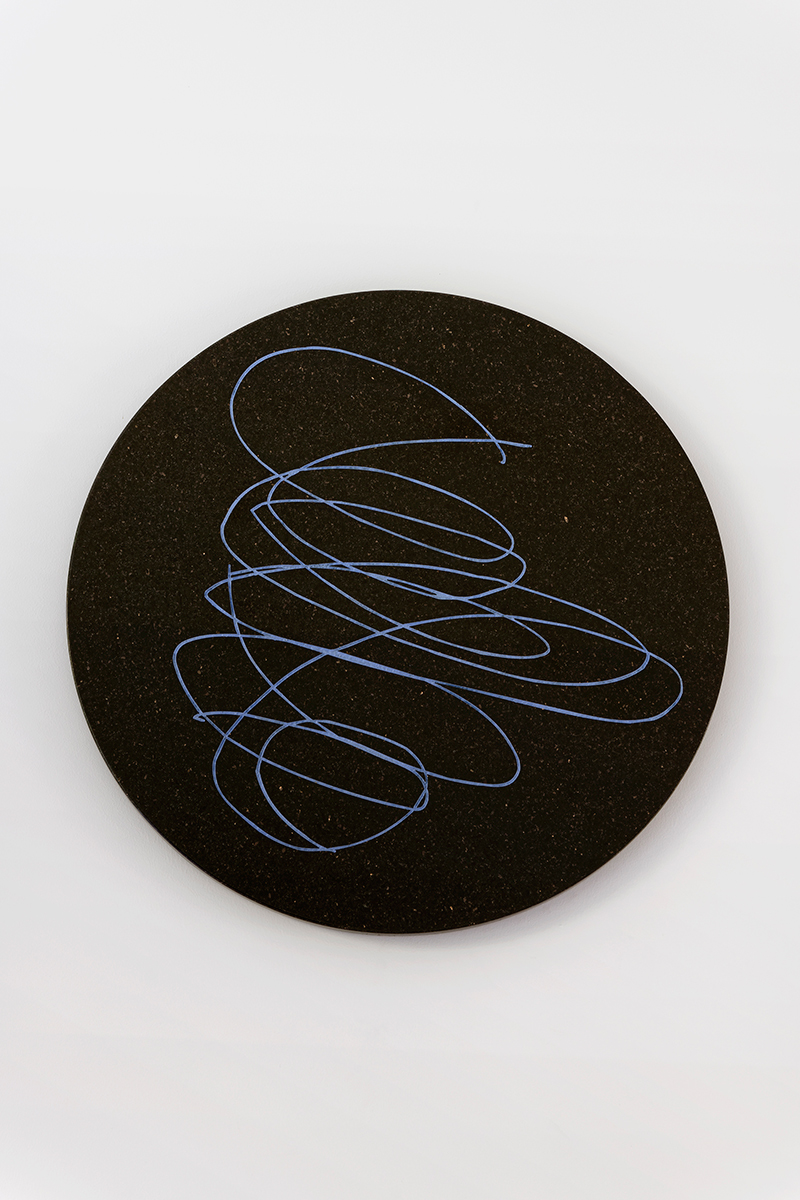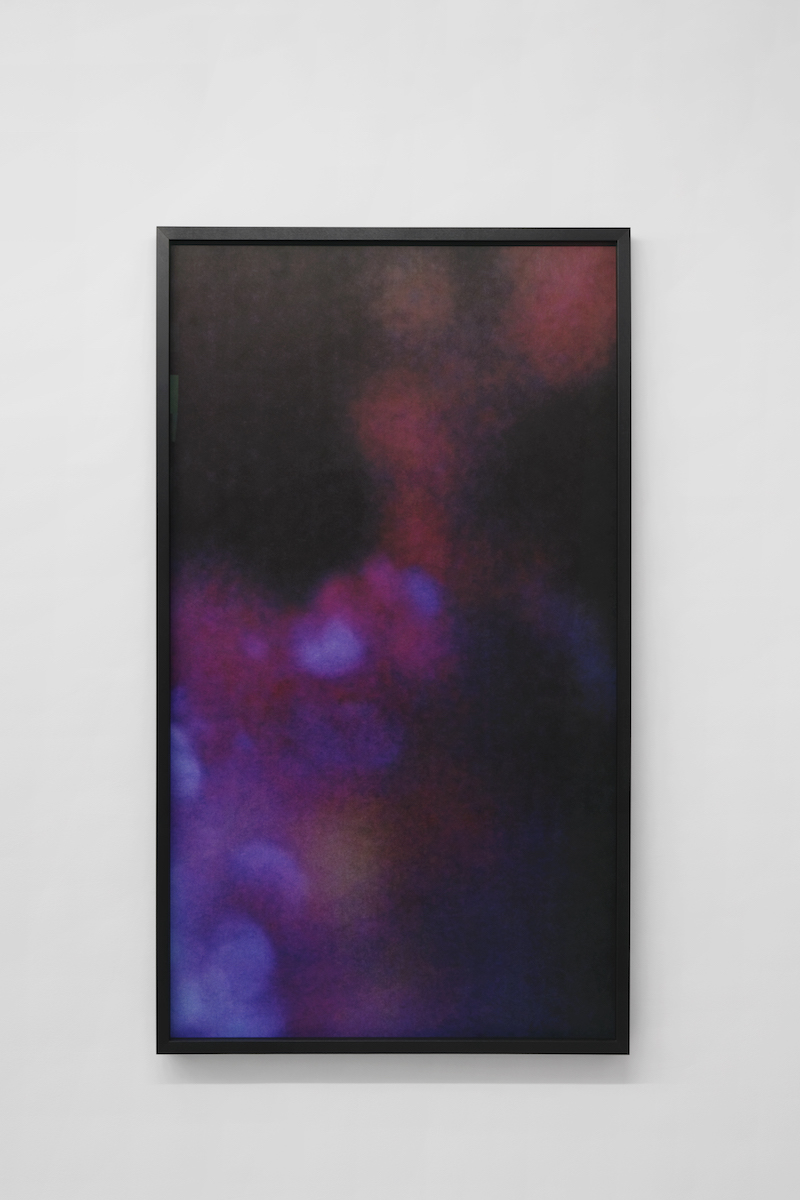Over The Air and Underground
— Angelica Mesiti
4th September, 2021 — 9th October, 2021Press release
We spin in circles in the night and are devoured by fire
“What do you do when your world starts to fall apart? I go for a walk, and if I’m really lucky, I find mushrooms.”(1)
Realised immediately after the first lockdown, Angelica Mesiti’s video installation Over the Air and Underground– which assembles flowers in various stages of decomposition in a dark, fluorescent circle– resonates with both our fears and recent delights manifested by the pandemic.(2) The associations that the piece evokes are multiple, and it is precisely this navigation that intrigues me: it allows us to evaluate what is happening to us, the bonds that form despite– and perhaps thanks to– the virus, the weaknesses that are also strengths. In the videos, the luminous filaments that cover the illuminated flowers with ultraviolet rays embody these links to be rebuilt and their brilliant intensity eloquently tells of the importance– and indeed the urgency– of such a project.
Angelica Mesiti chooses to produce forms by exploiting circumstances and deciding that they will not have the final say. She evokes her promenades during the first lockdown in this new work which appears in the wake of these solitary moments during which Paris (as it was in this city where she spent the lockdown) offered the only possible décor to our somewhat dazed gazes– a décor in which solely nature seemed to keep afloat. Like her, I remember gazing at plants unravelling between gutters and cracks in the walls as never before, and when I look at her piece today I understand the desire to evoke the secret communication between plants as forms of resistance to our suspended and hindered times.
I am not a specialist of what we call “nature writing,” however while preparing this text I reread Annie Dillard’s book dedicated to her walks in Virginia near her home at Tinker Creek. The book is majestic in its ability to name each species, each plant and their interactions with the sky, the weather and the seasons, but it is above all majestic for the unprecedented place it occupies for its author– a delighted astonishment, a joyful pleasure of discovery. “I am as passionately interested in where I am as is a lone sailor sans sextant in a ketch on the open ocean […] I’ve learned the names of some color-patches, but not the meanings. I’ve read books. I’ve gathered statistics feverishly […] These statistics, and all the various facts about the subatomic particles, quanta, neutrinos, and so forth, constitute in effect the infrared and ultraviolet light at either end of the spectrum. They are too big and too small to see, to understand; they are more or less invisible to me through present, and peripheral to me in a real sense because I do not understand even what I can easily see. I would like to see it all, to understand it, but I must start somewhere […]” she wrote.3
If one were to associate Annie Dillard's prose with the fundamental text that American anthropologist Anna Tsing published in 2015, one would approach in part the effect that Angelica Mesiti's installation produces. For in devoting her reflections to fungi, Anna Tsing focuses her efforts on the need to think about our world through the effects of precariousness and decay. She brilliantly describes how the notion of progress has lost all 'discursive relevance,' forcing us to reconsider our categories of thought and even more so our relationships, connections and echoes with the living world. By thinking through our vulnerabilities, Anna Tsing also allows us to see in a series of decaying, spinning flowers the image of a world we undoubtedly share.
But, there is a but. And it must be noted that neither Annie Dillard nor Anna Tsing offer the precise words to prepare ourselves for the coming night (the night to come?), with colours so acidic that they only sow acidity and disorder, with the infinite and therefore disturbing rotation Angelica Mesiti chooses to subject these flowers to. Surely it is there that the myth appears: “In former times, night did not exist. It was daylight all the time. Night slept beneath the waters. Animals did not exist either, for things themselves had the power of speech.”4 Another language emerges, one capable of describing dramatic and deliberate operations, such as those chosen to film these flowers. Thus, observation alone is not enough. Angelica says it herself, what interests her is the invisible circuits that allow plants to communicate with each other. These energetic exchanges are properly elusive, and when she tries to restore them thanks to this strange and anxious colour of the ultraviolet, her installation, as aquatic as it is terrestrial, borders on science fiction. These tones now colour her steps– and undoubtedly my own– on the Parisian asphalt during the lockdown in a different way. A large part of this confinement experience has bordered on the fantastic. Taking on all the appearances of our daily life– its decor, its gestures, its habits– these strange days have begun to turn on themselves, dervishes celebrating their own passage, day after day, and why not their own withering.
Angelica’s flowers remind me of American author Carmen Maria Machado’s short stories: they are part of a fantasy that has not erased either predation nor a certain belief/tendency of eroticization. This probably explains why part of our exchanges, when Angelica introduced me to the work, revolved around what she puts behind the word 'curiosity': a way of looking, of wanting to understand, of pushing open forbidden doors, of playing or mimicking scientific knowledge. After having tracked down and identified the flowers that would best lend themselves to the experiment, she had to create heat and humidity to orchestrate and accelerate their ageing in the studio chosen for the shooting. With ingredients that we would call "marshy" the environments palpitate, thrive even more. One can imagine whole populations of invisible species that populate and respond to them.
The fact that phenomena of extinction can be celebrated more than suffered is what a recent text by the poet and researcher Romain Noël helped me understand. That the dark areas of our environments can serve as a springboard for new and collective demands where the humming will be more audible, where the light filaments will not be so fragile after all, is what Angelica's piece in turn helps us to think. Don't bees see the world through ultraviolet tones– which is why the artist chose to conduct the experiment according to this chromatic grid? Didn’t Guy Debord name his most popular film We Go Round and Round in the Night and Are Consumed by Fire? From the precariousness that Anna Tsing uses as a starting point to simply describe our worlds, to the fantastic ecstasies that allow us to dream the obscure and that run through recent literature(5), we are better and better equipped to say: "There is no such thing as a nature morte." In homage to the rustling to come, “What appears then, at the time of the Anthropocene, is the growing desire to reach an area beyond binary oppositions that constitute the words as bequeathed to us. An area situated beyond or below these oppositions, or perhaps between the terms that compose them. This is of course the opposition between nature and culture, as well as between inside and outside, and from one thing to another. All oppositions of the world. Through our eyes damp with tears, an interstitial zone appears to us, and we start to think that it would be a better place to live.”(6)
— Clara Schulmann
Translated from the French by Katia Porro
2. The installation Over the Air and Underground is composed of 5 screens displaying revolving flowers. Captured in different stages of decomposition, they are covered in thin layers of mycelium and were filmed using solely ultraviolet light. The sound is composed of 10 human voices played on 10 speakers that form a choir of humming voices. The installation is a loop and the voices of the amateur singers begins slowly before experiencing a crescendo then diminishing. The frequency (220 Herz) chosen to render these voices is based on data from scientists who believe it to be the frequency used by tree roots when they communicate with each other.
3. Annie Dillard, Pilgrim at Tinker Creek, HarperCollins eBooks, 2007, p. 129-130.
4. “The Tupi of the Amazon,” in Claude Lévi-Strauss, From Honey to Ashes, 1973, New York, Harper & Row, p. 416.
5. I refer here to the collection of texts by Carmen Maria Machado published in French under the title Son corps et autres célébrations (2017), Editions de l'Olivier, 2019.
6. Romain Noël, “BDSM Apocalypse,” Klima, no. 2, 2019, p. 75. Translated by Katia Porro. Published in French on the website lundi matin on 22 March 2021. https://lundi.am/BDSM-Apocalypse
Over The Air and Underground
4th September, 2021 — 9th October, 2021 , 6 Passage Sainte-Avoye, Paris, 75003

Over The Air and Underground
4th September, 2021 — 9th October, 2021 , 6 Passage Sainte-Avoye, Paris, 75003

Over The Air and Underground
4th September, 2021 — 9th October, 2021 , 6 Passage Sainte-Avoye, Paris, 75003

Over The Air and Underground
4th September, 2021 — 9th October, 2021 , 6 Passage Sainte-Avoye, Paris, 75003

Over The Air and Underground
4th September, 2021 — 9th October, 2021 , 6 Passage Sainte-Avoye, Paris, 75003

Over The Air and Underground
4th September, 2021 — 9th October, 2021 , 6 Passage Sainte-Avoye, Paris, 75003

Over The Air and Underground
4th September, 2021 — 9th October, 2021 , 6 Passage Sainte-Avoye, Paris, 75003

Over The Air and Underground
4th September, 2021 — 9th October, 2021 , 6 Passage Sainte-Avoye, Paris, 75003

Over The Air and Underground
4th September, 2021 — 9th October, 2021 , 6 Passage Sainte-Avoye, Paris, 75003

Galaxy Noir (turning), 2021
Granite Galaxy Noir, engraving, enamel paint
60 x 2 cm
Courtesy the artist and Galerie Allen, Paris

Galaxy Noir (speaker), 2021
Granite Galaxy Noir, engraving, enamel paint
60 x 2 cm
Courtesy the artist and Galerie Allen, Paris

Fluoresce 1, 2021
Pigment inkjet print on Awagami Kozo paper
124 x 70 cm
Frame: 126.5 x 72.5 cm
Courtesy the artist and Galerie Allen, Paris

Fluoresce 2, 2021
Pigment inkjet print on Awagami Kozo paper
124 x 70 cm
Frame: 126.5 x 72.5 cm
Courtesy the artist and Galerie Allen, Paris

